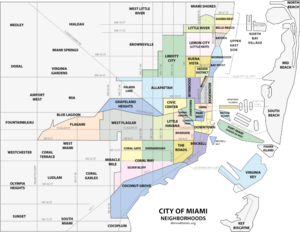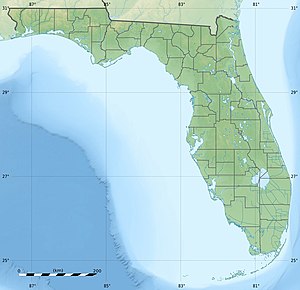Virginia Key
| Virginia Key | ||
|---|---|---|
| Waters | Atlantic Ocean | |
| Geographical location | 25 ° 44 ′ 11 ″ N , 80 ° 9 ′ 20 ″ W | |
|
|
||
| surface | 3.49 km² | |
Virginia Key is an island in Miami-Dade County in the US state of Florida between the Atlantic Ocean and Biscayne Bay . The barrier island also forms a district of Miami and has an area of 3.49 km². With downtown Miami and the island of Key Biscayne is key on the 1947 built Rickenbacker Causeway connected.
geography
Virginia Key, although referred to as "Key" , does not belong geologically to the Florida Keys , but is a barrier island made up of eroded sand from the Appalachians . This was transported by rivers to the Atlantic and then migrated southwards along the coast by coastal currents. There is no hard rock on the surface of the island, but only layers of soft “Shelly sandstone ” that reach depths of 30 meters or more. In the 1850s, Louis Agassiz noted that "there is no longer any quartz-rich sand to be seen south of Cape Florida ." (The beaches in the Florida Keys consist mainly of finely powdered mussel shells .) Geologists believe the island was around 2000 BC Formed shortly after the end of the sea level rise . The sand carried by the coastal currents began to pile up, forming new barrier islands off the southern coast of Florida.
Virginia Key expands in a northeast-southwest direction. The island is approximately three kilometers long and 1 to 2.5 kilometers wide. To the north of the island is Fisher Island , to the south is Key Biscayne .
history
Virginia Key Beach Park was established on the island in 1945. Until the end of segregation in South Florida in the 1960s, it was the only beach that could be used by African-Americans. In 1955 the Miami Seaquarium was opened on Virginia Key. The island is also home to the Maritime and Science Technology (MAST) Academy , the Rosenstiel School of Marine and Atmospheric Science and the Atlantic Oceanographic and Meteorological Laboratory (AOML) .
Attractions
- Virginia Key Beach Park
- Miami Seaquarium


